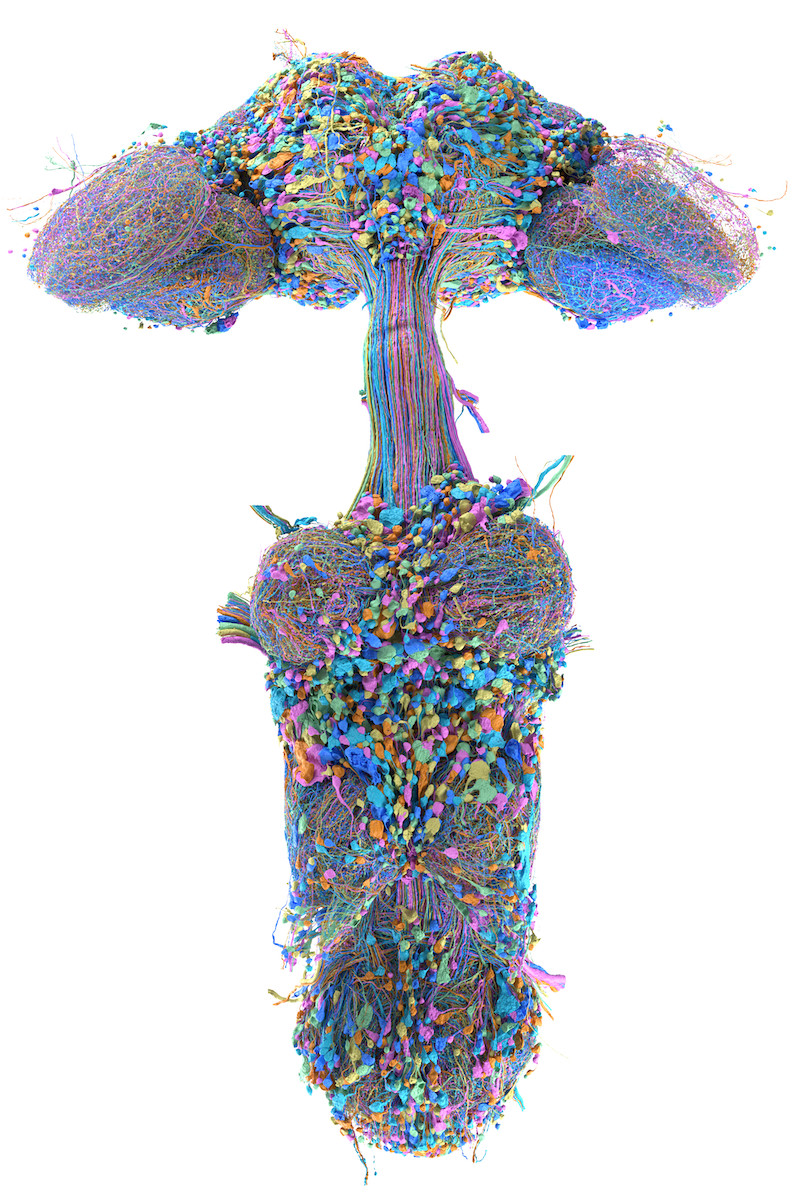
We present the first finished connectome of an entire male Drosophila central nervous system, encompassing the central brain, optic lobes (analogous to mammalian retina) and the ventral nerve cord (analogous to the spinal cord). This work extends the recent optic lobe connectome from the same specimen and provides two critical advances to Drosophila connectomics: a fully proofread and annotated brain and nerve cord connectome with an intact neck connective; and the first example of a male brain. Together with existing female connectomes, this resource enables the first comprehensive, synaptic-resolution comparison across sexes of an adult animal with complex anatomy and behaviors.
Comparing male and female fly brain connectomes, we identify 262 sex-specific and 114 sexually dimorphic cell types, comprising 4.8% of the central brain. Using whole-brain comparative connectomics, we reveal specific circuits originating from distinct sensory streams and uncover general principles governing how neural architecture encodes the capacity for sex-shared, sex-specific, and flexible behaviors.
We find that sex-specific and dimorphic neurons are concentrated in higher order brain centers while the sensory and motor periphery are largely isomorphic. Although these neurons comprise only a small fraction of all neurons, dimorphism propagates through the nervous system via dimorphic connectivity, substantiating a fundamental idea in connectomics that even modest changes in circuitry can exert brain-wide influence.
This resource enables exploration of neural circuits spanning the entire CNS and comparison of these circuits across sexes to elucidate the circuit-level impact of sexual dimorphism.
Male fruit fly CNS cell types
This video shows all the types of neuron cells in the central nervous system (brain and ventral nerve cord) of the male Drosophila fruit fly. Data acquired and analyzed by the FlyEM Project Team at HHMI-Janelia, the Cambridge Connectomics Group, and Google Research. Video by Philip Hubbard.
Example visual-motor pathway in the fruit fly
The central nervous system of the Drosophila fruit fly has visual-motor pathways, which connect the visual neurons that help the fly detect objects, and the motor neurons that help the fly move in response to those objects. This video shows an example of such a pathway, from R1-R6 visual neurons to the DNg13 motor neuron. Data acquired and analyzed by the FlyEM Project Team at HHMI-Janelia, the Cambridge Connectomics Group, and Google Research. Video by Philip Hubbard and Alexandra Fragniere.
Sexual dimorphism in the fruit fly central nervous system
Some neurons in the central nervous system of the Drosophila fruit fly are “dimorphic”, existing in both males and females but connecting to different neighboring neurons. The neighbors may be “isomorphic”, the same in both male and female, or sex specific, or dimorphic themselves. This video shows one example, the type AOTU012, which is present in left and right instances. Data acquired and analyzed by the FlyEM Project Team at HHMI-Janelia, the Cambridge Connectomics Group, and Google Research. Female data acquired by the FlyWire project. Video by Philip Hubbard and Isabella Beckett.
Getting Started
- Read the manuscript describing the dataset on bioRxiv.
- The MaleCNS Connectome site allows you to compare connectivity of dimorphic cells across the male and female fly connectome.
- Neuprint offers exploration of the connectome with connectivity queries and more.
- Programmatic access is possible via neuprint-python or the malecns R package from natverse.
- The MaleCNS Cell Type Explorer allows you to browse the cell types of the MaleCNS and rapidly explore type-to-type connectivity.
- Clio offers an annotation-focused interface finding neurons in the MaleCNS connectome.
- Neuroglancer is embedded in all of the tools above. Here is a standalone neuroglancer view of all MaleCNS image layers, including the segmentation, synapses, and neuropil compartments. It also includes co-registered neuron meshes from two female samples:
- NeuronBridge helps you find LM matches from the FlyLight catalogue (or your own LM images).
- Try VVDViewer with our unisex-transformed EM skeletons (see download page) to load LM and EM on your own machine.
- Image volumes, annotations, connectivity tables, etc. are available for download. See this page for details.
- If you have questions, problems, or comments, please post on relevant software github pages or in the neuPrint user group.
- The FlyEM Male CNS dataset is licensed under CC-BY.
Acknowledgements
Janelia’s FlyEM Project Team and the Cambridge Drosophila Connectomics Group/MRC LMB acquired, reconstructed, and annotated the EM dataset in collaboration with the Connectomics group at Google. This work was supported by the Howard Hughes Medical Institute and the Wellcome Trust in addition to core support from the Medical Research Council to the Laboratory of Molecular Biology. We also thank Janelia's FlyLight Project Team, Janelia Connectomics Annotation, Janelia Project Technical Resources, and Janelia's Fly Facility. The Janelia FlyEM Team Project operates under the guidance of its Steering Committee.
Male CNS dataset

The Male CNS dataset covers the fruit fly’s brain and ventral nerve cord.
News
- 2025-10-03: MaleCNS v0.9 released!
- 2025-10-30: Preprint v2 available on bioRxiv!
- 2025-11-07: NeuronBridge now provides matches for the MaleCNS!
